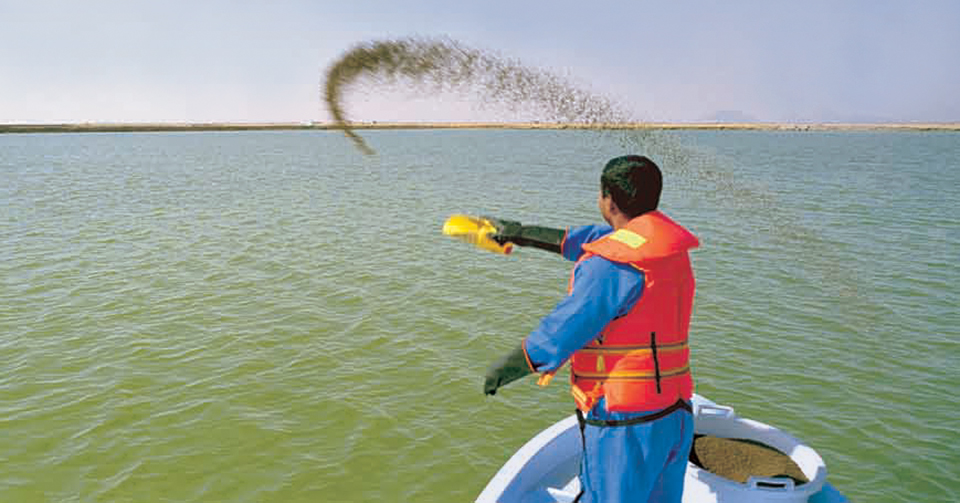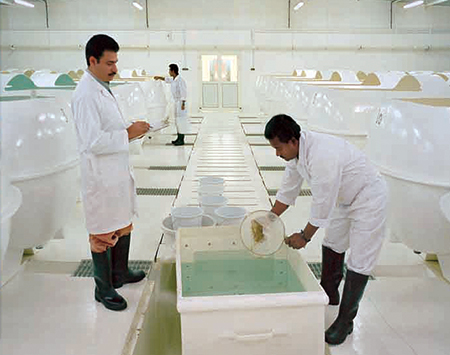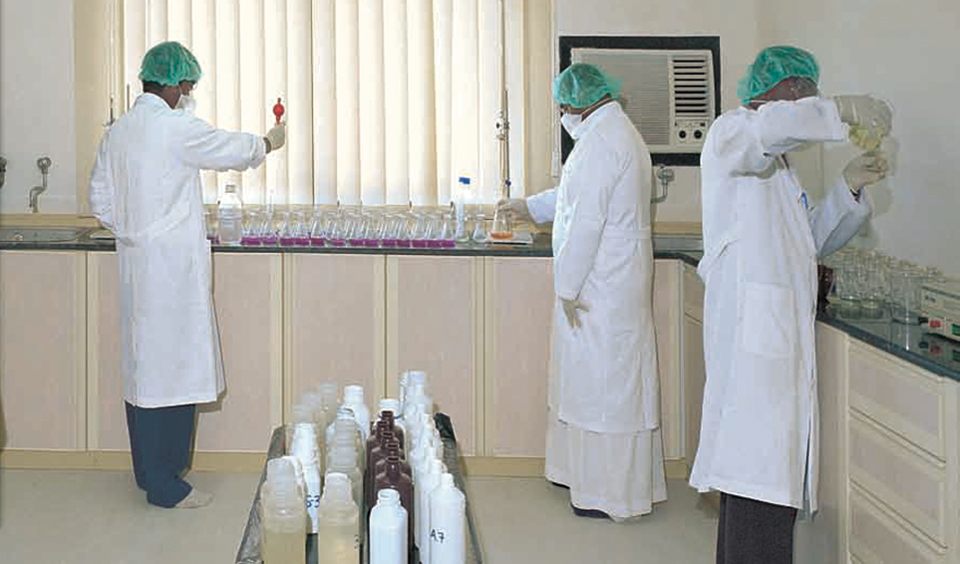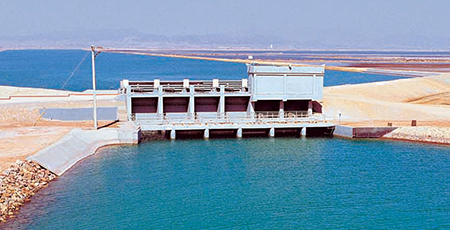Nurseries can produce 12,500 tons of Penaeus indicus

The specially formulated feed for NPC’s shrimp is manufactured on site.After 20 years of dedicated research and experimental operation, National Prawn Co. (NPC) has established the economic viability of prawn culture on the desert coast of the Red Sea in Saudi Arabia. Its operation, located 200 km south of Jeddah in southwestern Saudi Arabia, is one of the largest fully integrated desert coastal aquaculture projects in the world.
The construction of Phase I, representing 2,500 ha of water surface area, started in 1999 at an estimated cost of U.S. $200 million. Expected to be completed by the middle of 2004, it will be followed by Phase II, which will add an additional 3,400 ha of pond area.
As an integrated project, NPC has all the components required to support environmentally friendly shrimp production.
Hatchery, grow-out

National Prawn Co. maintains a series of sophisticated hatchery units that consist of two central nauplii production units and four intensive larval-rearing units. Total production capacity is 1 billion postlarvae per year using Galveston Technology with separate algae tanks. The postlarvae are specific pathogen-free and specific pathogen-resistant. The whole operation is backed up by an advanced domesticated broodstock program for Penaeus indicus.
NPC’s modified extensive farming system uses pristine Red Sea water. The system is supported by nurseries that cover 2,500 ha of water surface and can produce 12,500 metric tons (MT) Penaeus indicus per year.
Feed mill
A fully automated feed plant from Buhler, Switzerland, produces 50,000 MT per year of high-quality feed to meet the specific needs of desert coastal shrimp aquaculture.
Infrastructure, workforce
NPC’s water management system depends on an intake pumping station to pump water at 90 cubic meters per second through a series of main and feeder canals that total about 38 km in length. A drain pumping station of similar capacity pumps the naturally treated return water to the open sea.
A power plant with a capacity of 21.6 MW and a desalination plant with a capacity of 1,500 cubic meters per day handle the power and water needs of the project.
A talented, experienced multinational workforce, backed by specialists in different aspects of aquaculture, manages the system to achieve ISO status at all production facilities.
Research and development
NPC has a strong research and development team to solve site-specific problems related to biosecurity and shrimp health. It is supported by a sophisticated central laboratory that performs tests related to water quality, microbiology, polymerase chain reaction, histopathology, phycology and feed quality for environmental monitoring.
Processing plant

Shrimp processing is a competitive market, and in order to meet its demands, National Prawn Co. has made a large investment in a state-of-the-art processing plant at its farm site. Capable of handling 80 millimeter per day of head-on shrimp at nominal capacity, the plant is designed to process a wide variety of products, from simple block freezing to high-value, ready-to-eat, individually quick-frozen cooked products.

Since the processing plant is located within the farm site, product freshness is maintained very well until the product reaches the customer. The harvested shrimp reach the plant in less than one hour, where they are frozen in less than three hours from the time of harvest. The plant also has a large, fully automated chill room of 25 tons capacity to handle any bulk arrivals from the farm.
Three major process lines handle head-on shrimp with a capacity of 2 millimeter per hour and headless shrimp at 1.2 millimeter per hour. The peeling line can process 1 millimeter per hour.
Three plate freezers installed in the plant can freeze 20 millimeter per day. The two spiral freezers have a capacity of 0.8 millimeter per hour. There are also two flow-pack machines. As part of its worldwide marketing strategy, National Prawn Co. has given much importance to the implementation of HACCP and ISO quality control systems. Their application is in tune with the company’s quality policy to deliver only safe products for its demanding customers.
(Editor’s Note: This article was originally published in the October 2003 print edition of the Global Aquaculture Advocate.)
Now that you've finished reading the article ...
… we hope you’ll consider supporting our mission to document the evolution of the global aquaculture industry and share our vast network of contributors’ expansive knowledge every week.
By becoming a Global Seafood Alliance member, you’re ensuring that all of the pre-competitive work we do through member benefits, resources and events can continue. Individual membership costs just $50 a year. GSA individual and corporate members receive complimentary access to a series of GOAL virtual events beginning in April. Join now.
Not a GSA member? Join us.
Author
-
Eng. Ahmed R. Al Balla
National Prawn Co.
P.O. Box 2520
Al Lith 21961
Kingdom of Saudi Arabia
Tagged With
Related Posts

Intelligence
Can shrimp follow the avocado example?
Producers of high-quality, sustainable shrimp have a great story to tell. They just need to come together and shout it out like avocado producers did.

Health & Welfare
Shrimp biofloc production trials in Saudi Arabia
An R&D trial was conducted with shrimp biofloc technology at a commercial facility in Saudi Arabia. Results indicated that biofloc technology can be effectively applied, with some protocol adjustments, in the KSA’s extreme desert environmental conditions.

Health & Welfare
Saudi Arabia developing effective farmed shrimp biosecurity strategy
Biosecurity strategies adopted by the shrimp industry in the Kingdom of Saudi Arabia have resulted in historical production in 2015 and a similar forecast for 2016, and are a significant step towards the long-term goal of sustainable aquaculture.

Intelligence
The Arab region seafood marketplace, part 1
All 22 Arab countries are producers, importers, exporters and consumers of seafood products. The total seafood production from capture and aquaculture was 4.7 million metric tons in 2016, of which 1.5 million metric tons (36 percent) was from aquaculture.


